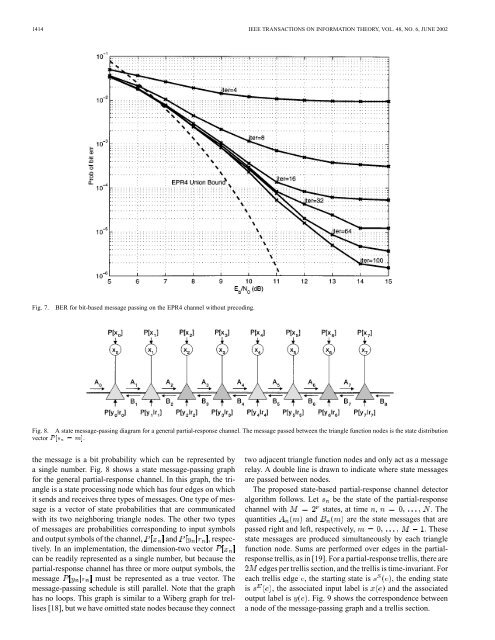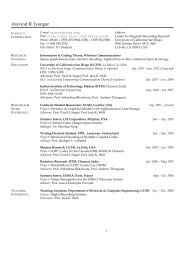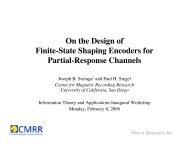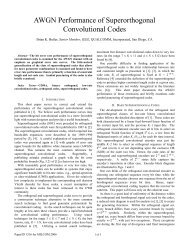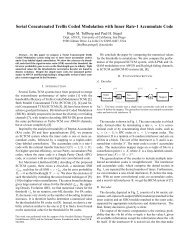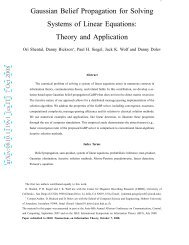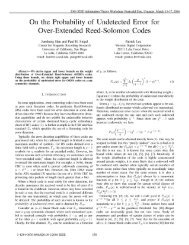Joint message-passing decoding of LDPC codes and ... - CiteSeerX
Joint message-passing decoding of LDPC codes and ... - CiteSeerX
Joint message-passing decoding of LDPC codes and ... - CiteSeerX
You also want an ePaper? Increase the reach of your titles
YUMPU automatically turns print PDFs into web optimized ePapers that Google loves.
1414 IEEE TRANSACTIONS ON INFORMATION THEORY, VOL. 48, NO. 6, JUNE 2002<br />
Fig. 7.<br />
BER for bit-based <strong>message</strong> <strong>passing</strong> on the EPR4 channel without precoding.<br />
Fig. 8. A state <strong>message</strong>-<strong>passing</strong> diagram for a general partial-response channel. The <strong>message</strong> passed between the triangle function nodes is the state distribution<br />
vector P [s = m].<br />
the <strong>message</strong> is a bit probability which can be represented by<br />
a single number. Fig. 8 shows a state <strong>message</strong>-<strong>passing</strong> graph<br />
for the general partial-response channel. In this graph, the triangle<br />
is a state processing node which has four edges on which<br />
it sends <strong>and</strong> receives three types <strong>of</strong> <strong>message</strong>s. One type <strong>of</strong> <strong>message</strong><br />
is a vector <strong>of</strong> state probabilities that are communicated<br />
with its two neighboring triangle nodes. The other two types<br />
<strong>of</strong> <strong>message</strong>s are probabilities corresponding to input symbols<br />
<strong>and</strong> output symbols <strong>of</strong> the channel, <strong>and</strong> , respectively.<br />
In an implementation, the dimension-two vector<br />
can be readily represented as a single number, but because the<br />
partial-response channel has three or more output symbols, the<br />
<strong>message</strong> must be represented as a true vector. The<br />
<strong>message</strong>-<strong>passing</strong> schedule is still parallel. Note that the graph<br />
has no loops. This graph is similar to a Wiberg graph for trellises<br />
[18], but we have omitted state nodes because they connect<br />
two adjacent triangle function nodes <strong>and</strong> only act as a <strong>message</strong><br />
relay. A double line is drawn to indicate where state <strong>message</strong>s<br />
are passed between nodes.<br />
The proposed state-based partial-response channel detector<br />
algorithm follows. Let be the state <strong>of</strong> the partial-response<br />
channel with states, at time , . The<br />
quantities <strong>and</strong> are the state <strong>message</strong>s that are<br />
passed right <strong>and</strong> left, respectively,<br />
. These<br />
state <strong>message</strong>s are produced simultaneously by each triangle<br />
function node. Sums are performed over edges in the partialresponse<br />
trellis, as in [19]. For a partial-response trellis, there are<br />
edges per trellis section, <strong>and</strong> the trellis is time-invariant. For<br />
each trellis edge , the starting state is , the ending state<br />
is , the associated input label is <strong>and</strong> the associated<br />
output label is . Fig. 9 shows the correspondence between<br />
a node <strong>of</strong> the <strong>message</strong>-<strong>passing</strong> graph <strong>and</strong> a trellis section.


